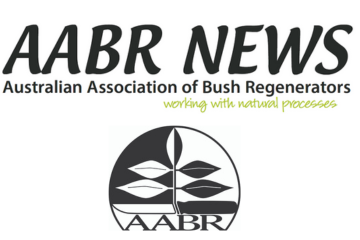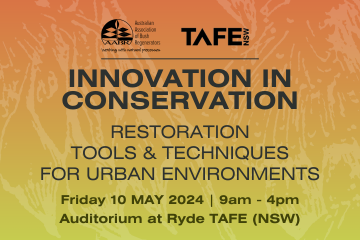It is not unusual for ecological restoration practitioners to be involved in the arts – or for artists to be involved in ecological restoration. After all, both fields are fundamentally creative ones. AABR News is keen to publish short interviews with people that fall into either category over the coming months and years. In this issue Louise Brodie (LB) talks to our interviewee Tein McDonald (TM) who recently held an exhibition titled Layers of Landscape at Cooma’s Raglan Gallery.
LB: Tein – I understand that the theme related to various aspects of landscape, but could you describe a couple of the works and how you set about getting the idea for the exhibition; was it past works that came together, or did you plan it from scratch?
TM: Well – a bit of both. The exhibition contained five paintings that I started some decades ago when I found myself working closely with Bandjalang elders in the Coraki-Evans Head area on the north coast of NSW. They were like a private diary back in those days, recording ways the Bandjalang custodians survived a chain of disasters and abuses yet continue to care for their landscapes. But a few years ago I gained the blessing of the current elders to finish them and show them to visitors to a gallery as a personal contribution towards truth-telling before they were returned to the homes of the elders where they belong.
So they were the older works – but the exhibition also included another 20 paintings and photographs that were more recent and focus on other aspects of landscape.
LB: And did you include any about bush regeneration as a theme?
TM: Well, the show included the Blue Signatures statement that the last AABR News published a short snippet on (see News 157). That work referenced the actions of many people in bush regeneration and emphasised my view that I consider the actual work on the ground to be the real art work…not the photo or the painting that represents it in a gallery. This was the message of one of the Bandjalang paintings too – which referred to on-ground bush regeneration carried out collaboratively between Aboriginal and non-Aboriginal partners.
But the exhibition also included a series of five paintings that I refer to a ‘land repair’ series. Four of these were comprised of two panels – the upper panel showing the process of degradation over time and the lower panel showing the process of recovery over time. They were fun to do and fun to explain to people because they are about real restoration sites in NSW – not ones that I have personally worked on but ones that I have visited and inspire me.
There was a fourth series of paintings and photographs that did not have a particular message other than celebrating the beauty of patterns in nature – whether the micro-landscapes that can be found in tree barks or leaf litter or larger scale landscapes. I feel it is important for painting to communicate beauty through colour and texture and pattern to touch the soul a little. That’s why they have music in churches I guess….you can’t preach all the time. Sometimes you have to let art talk.
LB: Did you feel that people who came to the exhibition got an understanding of bush regeneration or an appreciation of bushland?
TM: The response was very encouraging. Of course those who already had some understanding and appreciation of bushland got more out of it – but I’m sure others learnt at least something from the exhibition. I was amazed when one couple from France stayed for two hours reading the explanatory boards and looking at the paintings. About halfway through the exhibition period I advertised a ‘walk around the gallery with the artist’ that was pretty well attended for a small country gallery. I can’t say whether it had an effect but it opened up some conversations and it gave me a good deal of satisfaction to be able to give people a bit more insight into the paintings and the themes they covered.
Tein’s art website can be viewed at https://teinmcdonald.com.au/






Leave A Comment